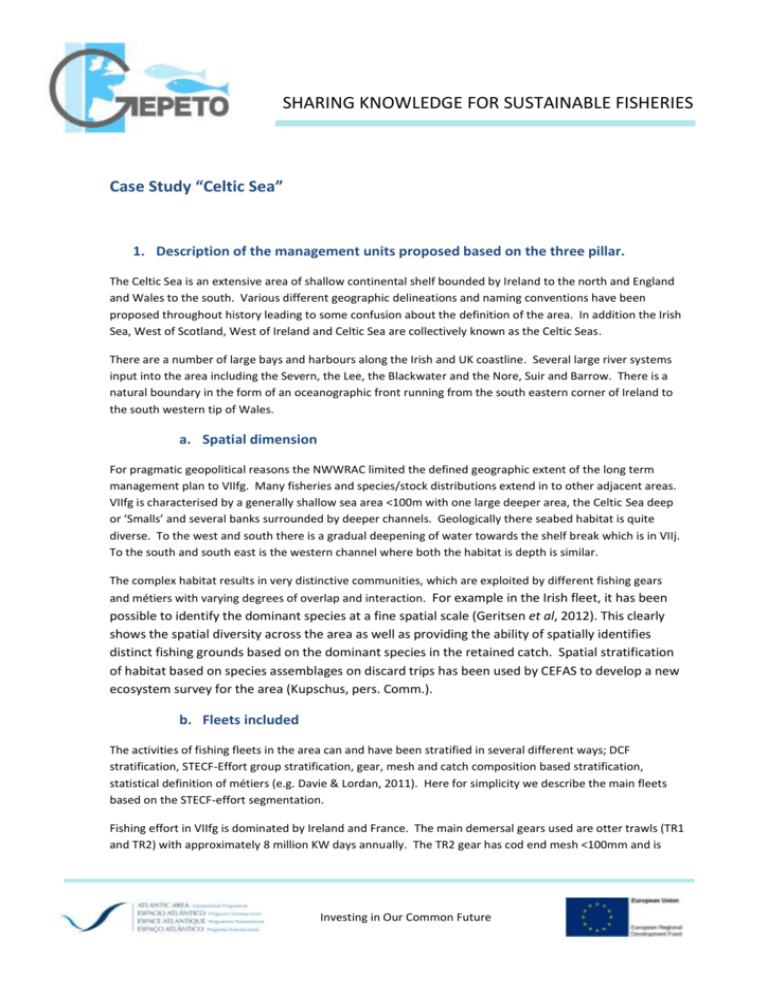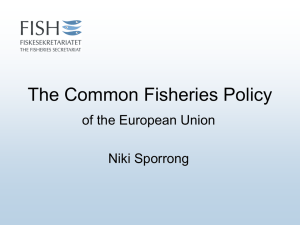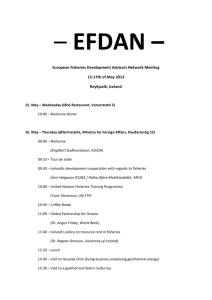Management Unit definition_Celtic Sea
advertisement

SHARING KNOWLEDGE FOR SUSTAINABLE FISHERIES Case Study “Celtic Sea” 1. Description of the management units proposed based on the three pillar. The Celtic Sea is an extensive area of shallow continental shelf bounded by Ireland to the north and England and Wales to the south. Various different geographic delineations and naming conventions have been proposed throughout history leading to some confusion about the definition of the area. In addition the Irish Sea, West of Scotland, West of Ireland and Celtic Sea are collectively known as the Celtic Seas. There are a number of large bays and harbours along the Irish and UK coastline. Several large river systems input into the area including the Severn, the Lee, the Blackwater and the Nore, Suir and Barrow. There is a natural boundary in the form of an oceanographic front running from the south eastern corner of Ireland to the south western tip of Wales. a. Spatial dimension For pragmatic geopolitical reasons the NWWRAC limited the defined geographic extent of the long term management plan to VIIfg. Many fisheries and species/stock distributions extend in to other adjacent areas. VIIfg is characterised by a generally shallow sea area <100m with one large deeper area, the Celtic Sea deep or ‘Smalls’ and several banks surrounded by deeper channels. Geologically there seabed habitat is quite diverse. To the west and south there is a gradual deepening of water towards the shelf break which is in VIIj. To the south and south east is the western channel where both the habitat is depth is similar. The complex habitat results in very distinctive communities, which are exploited by different fishing gears and métiers with varying degrees of overlap and interaction. For example in the Irish fleet, it has been possible to identify the dominant species at a fine spatial scale (Geritsen et al, 2012). This clearly shows the spatial diversity across the area as well as providing the ability of spatially identifies distinct fishing grounds based on the dominant species in the retained catch. Spatial stratification of habitat based on species assemblages on discard trips has been used by CEFAS to develop a new ecosystem survey for the area (Kupschus, pers. Comm.). b. Fleets included The activities of fishing fleets in the area can and have been stratified in several different ways; DCF stratification, STECF-Effort group stratification, gear, mesh and catch composition based stratification, statistical definition of métiers (e.g. Davie & Lordan, 2011). Here for simplicity we describe the main fleets based on the STECF-effort segmentation. Fishing effort in VIIfg is dominated by Ireland and France. The main demersal gears used are otter trawls (TR1 and TR2) with approximately 8 million KW days annually. The TR2 gear has cod end mesh <100mm and is Investing in Our Common Future SHARING KNOWLEDGE FOR SUSTAINABLE FISHERIES mainly targeting Nephrops. The TR1 gear with >100m is used to target mixed roundfish (cod, haddock and whiting) and/or benthic species (monkfish, megrim, hake). The UK and Belgium dominate the beam trawl fisheries in VIIfg (BT) which show a declining trend in effort since 2003. Beam trawls are used to target sole, plaice, monkfish and megrim. There are lesser amounts of effort using various forms of gill nets and longlines in VIIfg. There are other important shellfish fisheries (pot and dredge) and pelagic fisheries (mainly pelagic trawl) fishery operating in VIIfg. While these fisheries are not the main focus of the management plan they do interact with demersal fisheries in the area. c. Fish/shellfish communities included Demersal fisheries in the Celtic Sea catch a wide variety of fish and shellfish species. For example demersal trawl surveys in this area catch >100 fish species annually (Marine Institute, 2012). Notwithstanding the diversity in demersal species community the top 20 species account for ~ 95% of landings ICES carries out assessments and provides some form of management advice for 10 of the most important demersal species/groups which account for ~ 78% of the total demesal landings biomass from VIIfg (Figure 1). Landings from the eastern part of the Celtic Sea tend to be more mixed and dominated by mixed-gadoids. There are distinct areas where targeted Nephrops and flatfish operate. The western parts of the Celtic Sea tend to be dominated by hake, monkfish and megrim. There are also a number of important species which are not subject to TAC constraints and are not currently subject to analytical stock assessments. Investing in Our Common Future SHARING KNOWLEDGE FOR SUSTAINABLE FISHERIES Figure 1 Percentage of total demersal landing by weight for the top 20 species from VIIfg. Stocks for which ICES provided management advice are shown in dark grey. 2. Objectives of the management: In common with the majority of EU demersal fisheries, those in the Celtic sea can be characterised as being biologically and technically diverse with discarding of juvenile and over quota species problematic for many demersal species. In such fisheries, it is not entirely possible to control which species and how much of each is caught. In fact the economics will drive fishers to make best use of all TACs available to them. Under the current management approach, where single species TAC’s are largely set without due consideration of these technical interactions, the TACs for some stocks are exceeded in trying to maximise the TACs of other stocks. Unless tactical and technical adaptations are introduced, it may not be possible to attain single-stock MSY levels and maximise potential yield simultaneously. Additionally, improvements in selection pattern for many of the key species could result in short and medium terms gains as higher section patterns are consistent with increases in Fmsy targets and therefore yield (STECF, 2012) it is therefore important that the effects of changes in exploitation pattern are also considered in the context of setting fishing opportunities. Investing in Our Common Future SHARING KNOWLEDGE FOR SUSTAINABLE FISHERIES Between 2010 and 2011 the NWWRAC developed and approved a framework and objectives for a mixed demersal fisheries management plan in the Celtic Sea (ICES Divisions VIIfg). Figure 2 gives a schematic overview of the structure of this management plan. The plan itself was initially based on the Gulf of Alaska mixed fishery plan and it evolved through various consultations and deliberations at NWWRAC CS focus group meetings. The general aim of this plan is to address the high level CFP objectives by applying management measures at an appropriate region scale. The plan should be very much bottom up such that management objectives, tools, costs and trade offs are developed and applied in a transparent and considered way in consultation will key stakeholders. International experience has shown that this type of management paradigm has performed better (Hilborn, 2007). 2011 - NWWRAC Celtic Sea MP Transitional Biological Long-Term Objectives Economic Social Figure 2 Schematic overview outlining the structure of the NWWRAC CSLTMP. 3. Management tools: Fisheries in the Celtic Sea are mainly managed by a complex mixture of input and output controls including: • • TACs (Council Regulation EC No 39/2013) Disparate national quota management arrangements (e.g. http://www.agriculture.gov.ie/fisheries/fisheriesmanagementnotices/fisheriesmanagementn otices2013/) Investing in Our Common Future SHARING KNOWLEDGE FOR SUSTAINABLE FISHERIES • • • • • • • • • Mesh regulations and minimum landings sizes MLS (e.g. Council Regulations 850/98) National management measures, licensing and market control regimes (e.g. http://www.agriculture.gov.ie/fisheries/seafisheriesadministration/fishingboatlicensing/) Effort & capacity ceilings (Council Regulation EC No 1415/2004) Spatio-temporal closure ‘Trevoes box’ (Council Regulations 27/2005, 51/2006, and 41/2007, 40/2008, and 43/2009). Mesh regulations associated with the hake recovery plan BSA – Irish Box (Figure 6.3 and Council Regulation No. 1954/2003) Natura 2000 special areas of conservation (Figure 6.5) Discard reduction TCMs (EC Regulation 737/2012) There are also developing proposals by the UK to introduce further Marine Conservation Zones or MSZ in the Celtic Sea. Despite all of the above there is a perception by fishermen and mangers alike that these are not working appropriately. During GEPETO meetings various other management measures have been discussed and proposed including effort control (without quotas), Real Time Incentives RTIs (Kraak, et al. 2012), mesh size and TCM changes and additional closed areas. The NWWRAC management plan has stipulated at its core “catch based management” with discard reductions envisaged and a results based management system rather than prescriptive regulations. 4. Regional management bodies All fisheries in this area are within the remit of the CFP. DGMARE is the European Commission section with responsibility for implementing the CFP. A new Common Fisheries Policy (CFP) has been agreed by Council and Parliament and is effective from 1 January 2014. The new CFP seeks to bring fish stocks back to sustainable levels, put an end to wasteful fishing practices, and create new opportunities for jobs and growth in coastal areas. To achieve this it focuses on banning discards, empowering the sector and decentralising decision making, prioritising aquaculture, supporting small scale fisheries, improving the scientific knowledge on the state of stocks, and taking responsibility in foreign waters through the EU's international agreements. Since the reform of the CFP the managing authorities in several Member States of the EU i.e. Ireland, France, Spain, UK, Belgium and the Netherlands have been meeting monthly to develop regionalised management plans including in the area covered by this NWWRAC CSLTMP. 5. Monitoring system Investing in Our Common Future SHARING KNOWLEDGE FOR SUSTAINABLE FISHERIES The main stocks in this area are covered under the Data Collection Framework which implements a data collection regime to support the CFP (EC, 2008).. Various control regulations also apply to monitor landings, catches and effort and set out reporting requirements at a vessel and national level (EC, 2010). 6. Assessment and advisory system Most stocks and fisheries are assessed and advised on by ICES and STECF. The ICES expert groups and the main stocks assessed are listed below. ICES EG Stock Names & Codes WGCSE Celtic Sea cod (cod-VIIek), Celtic Sea Haddock (had-VIIb-k), SW Ireland Nephrops (nep-19), Labadie Nephrops (nep-20-21), Smalls Nephrops (nep-22), Celtic Sea Plaice (ple-celt), Celtic Sea Sole (sol-celt), Celtic Sea whiting (whg-VIIb-k) Pollock in VII (pol-VII) WGBIE Anglerfish (L. budegassa) in the Celtic Sea and Bay of Biscay (anb-78ab), (WGHMM) Anglerfish (L. piscatorious) in the Celtic Sea and Bay of Biscay (anp-78ab), Megrim in the Celtic Sea and Bay of Biscay (mgw-78) WGEF Rays and skates in the Celtic Sea ecoregion Single species stock assessments and short-term forecast are carried out for most stocks. The ICES data limited approach is also applied for some stocks to produce landings or catch advice. Effort data at national and gear level are aggregated by STECF for the VIIfg area annually. The NWWRAC is stakeholder-led Advisory Councils that provide the Commission and EU countries with recommendations on fisheries management matters. Investing in Our Common Future








